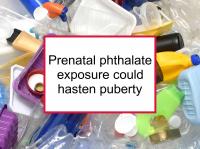Phthalates are a class of chemicals commonly used to make plastics more pliable and as additives in personal care products. Food packaging, body lotions, and face creams are the main sources of phthalate exposure for most people. Even low level exposure to phthalates has been shown to increase breast cancer cell proliferation.
Women with breast cancer had higher phthalate levels than cancer-free controls in one study. Average exposures among U.S. consumers are below unsafe levels, according to the Environmental Protection Agency (EPA). However, note that European regulations are stricter with regard to phthalate exposure and consumers there enjoy a higher level of protection.
In addition, there is very little data on the effects of chronic phthalate exposure or the combination of phthalates with other endocrine disruptors or carcinogens.
Now a new study has reported that girls significantly exposed to phthalates while in the womb are more likely to experience early puberty than those who are not. Early puberty is a risk factor for breast cancer.
Avoiding exposure to phthalates
While more studies are needed to clarify the association between typical U.S. phthalate levels and breast cancer risk, taking steps to reduce exposure makes sense. One study measured phthalate metabolites in the urine of study participants before, during and after a non-packaged foods dietary intervention.
Participants ate their usual diet, then for three days consumed only fresh foods (no canned food or food packaged in plastic and no restaurant meals), after which they returned to their normal diet. Consuming fresh food only reduced the levels of phthalate metabolites by more than 50%.
Phthalates such as diethyl phthalate (DEP) and dibutyl phthalate (DBP), and monoethyl phthalate (MEP), which are used in lotions and creams, can be absorbed through the skin.
Another study found that concentration of the compounds peaked in the urine within eight to 12 hours after phthalate-containing cream was applied. In other words, phthalates are absorbed into circulation and metabolized following application to the skin.
Avoiding phthalates in personal care products by checking ingredient labels for "phthalate" and emphasizing fresh rather than packaged or restaurant foods are steps that can be taken to reduce exposure.
In addition, some plastic containers are marked with a recycling number in a triangle-shaped icon. Plastics marked with the number 3 should be avoided since they incorporate polyvinyl chloride, which contains phthalates.
Latest research finds exposure to phthalates might hasten puberty
The study referenced at the beginning of this news story was designed to examine the associations between prenatal and peripubertal (around the time of puberty) bisphenol A (BPA) and phthalates exposures and onset of puberty. The age of puberty has been dropping over recent decades. Previous research suggests that endocrine disruptors might be partially responsible.
However, the role of endocrine disruptors at multiple stages of development has not been investigated. In the study, the authors examined the effects of exposure to BPA and phthalates both in the womb and around puberty.
The study included 119 women and their 129 daughters in Mexico City. Urinary phthalate metabolite and BPA concentrations were determined for the mothers during their third trimester and for their daughters at ages 8 to13. Serum hormone concentrations, Tanner stages for breast and pubic hair development, and information on age at first period were also collected for the daughters.
Excluding outliers, girls with the greatest prenatal exposure to mono-2-ethylhexyl phthalate (MEHP) were found to have significantly higher levels dehydroepiandrosterone sulfate (DHEA-S, an early indicator of puberty) and sharply higher likelihood of a Tanner stage > 1 for pubic hair development than girls with low exposure. Similar relationships were found for other prenatal, but not peripubertal, di-2-ethylhexyl phthalate (DEHP) metabolites.
Higher in utero exposures to monobenzyl phthalate (MBzP) and monoethyl phthalate (MEP) were also found to be associated with significantly higher serum testosterone concentrations. The authors found non-significant associations between prenatal and peripubertal MEP exposures and increased likelihood of having undergone menarche, and between peripubertal MnBP concentrations and increased likelihood of having a Tanner stage > 1 for both breast development and pubic hair appearance. On the other hand, BPA was not found to be associated with prenatal or peripubertal hormone levels or onset of puberty.
The authors conclude that prenatal exposure to phthalates might influence circulating hormone levels during peripubescence and the timing of sexual maturation. Efforts to control phthalate exposure during pregnancy should be of high priority, according to the authors.
Please see our articles on phthalates and the prenatal period and infancy for more information.
